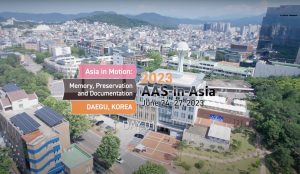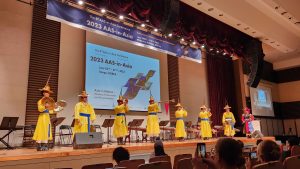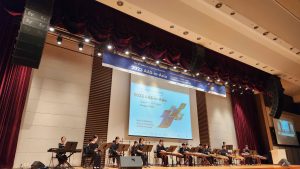- Essays
2023.06.30
2023 AAS-in-Asia in Daegu, Korea

Reports on 2023 AAS-in-Asia Daegu (1)
Shigeto Sonoda
As delegates from GAS program, Prof. Kim and I attended the three-day-long AAS-in-Asia hosted by Kyungpook National University in South Korea from 24th to 27th of June, 2023. I attended two roundtables as an audience (Asian Scholarly Publishing and Asian Studies) as well as a panelist (Asian Studies in Asia: Questioning Assumptions and Challenging Boundaries) on 24th and two sessions (Transgressing the Homeland: Zainichi’s Koreans Under the Cold War Regimes and Asia in Motion: Bridging East, South, and Central Asia) and one special roundtable (Asia at a Critical Juncture: Reflections on China-Japan-Korea Relations) as an audience. Through participations in the roundtables and sessions above, I got the following observations.
Firstly, researchers from US and Singapore were “overrepresented” while those who were from China and Japan, which developed their own Asian studies in their local languages, were ‘underrepresented.’ Probably due to the high cost to join the conference, Southeast Asian scholars (except those from Singapore) were also fewer in number, which made me question the meaning of “in Asia” in “AAS-in-Asia.” AAS (Association for Asian Studies) is definitely a US-based association, but if “in Asia” means just an extension of the venue for the conference, its attractiveness will be lost.
Secondly, Asian studies in Asia are very different from those in US where Asian studies are coming to be connected to American studies due to the decreasing popularity of conventional Asian studies (as the studies of “others”) and financial backup by funding agencies, while Asian studies in Asia are developing to know “ourselves” rather than “others.” When it comes to the current situation of Asian studies in Asia, however, they are so different from each other due to locally different trajectories of development. China studies in Japan, for example, have come to be led by Chinese migrants while China studies in Korea are still led by local Koreans due to linguistic reasons. At a roundtable session I attended, panelists discussed the impacts of increasing open access in journal papers, but as one panelist pointed out, the situation is so different between English journals and journals in non-English languages which have received strong influence by the national policies.
And thirdly, there are some pros and cons about the presentation by non-native speakers of English to present their researches in English. More detailed discussion might be possible by using their local languages and in many cases local languages might have more relevant references in non-English speaking countries (like the case of Zainichi studies), while presentation in English will evoke more unexpected and wide-ranged questions (like the case of Asia in Motion session) and comments from those who are not familiar with the topics and countries that local researchers are addressing to. In fact, trilateral discussion among China, Korea, and Japan in local languages would have been more detailed and often times more “emotional,” but discussion in English at the special roundtable evoked questions from those who were not familiar with very nuanced relations among these three counties.
To sum, I realized Asian studies in Asia have many things to do. As a chair concluded in the roundtable, intra-Asian dialogues are more and more important, which our GAS program is aiming at.
Reports on 2023 AAS-in-Asia Daegu (2)
Jiyoon Kim
2023 AAS-in-Asia was held in Daegu, a major battlefield and defense line of the Korean War that broke out on June 25th, 1950, which resonated with the overarching theme of this year, Asia in Motion: Memory, Preservation, and Documentation. On 24th, I attended two panels (Re-Centering Migration into South Korea and Migrants and Everyday Bordering in Contemporary South Korea) and one keynote (Remembering the 1951–1953 War in Korea). All of these were rooted not only in the contemporary and historical context of Korea but were also deeply connected to the global terrain. Additionally, I attended three panels that comprised interesting comparisons and collaborations (Comparing Contact Zones in Northeast Asia: Mediations, Negotiations, and Reversals; Race-Making, Identity-Making, Memory, and the Perry Expedition to Japan, 1852-Today; and Pacific Thoughts and Alternative Aesthetics). The other two panels I attended were a roundtable and an organized panel to exchange experiences of doing Asian studies from different disciplinary settings and to discuss the current state of doing Asian studies within or outside Asia (From Latin America to Northeast Asia via South and Southeast Asia: Charting the Future of Asian Studies and Bringing Humanity Back to Asian Studies and Academia: An Interdisciplinary Dialogue).
Firstly, I thought it especially impressive and meaningful that this year’s event was held in Daegu, rather than in a more accessible and recognized metropolis or capital city such as Seoul or Busan. Beyond my shallow knowledge of the city’s conservative local culture and far-right political stance, Daegu presented many faces and multilayered glocality that could communicate with numerous other sites in Asia. As addressed in the keynote, it is a good place to think about transnational memory politics and its communicative nature in/of Asia. As discussed in the panel ‘Migrants and Everyday Bordering’, it is one of the dynamic fields that shows the current racialized imaginaries of islamophobia against foreign students and migrants, as well as anti-islamophobia activism by local activists and student-faculty groups. Viewing from Daegu, the locality and local history of the conference site offer a resource to reflect on Asian studies by giving participants more vivid experience of its past and present. This can eventually lead us to recall and recontextualize our own locations and histories, which are always attached to specific placeness. So, the first keyword that I observed is locality, as well as its concurrent glocality.
Secondly, some panels made me think what, or how far, comparison and collaboration can do. For example, the contact zone session was composed of very distant times, i.e., Baekche in the 8th century, Heian Japan in the 11th century, and the Japanese tour to the Korean peninsula and southern Manchuria in 1906. Even though each panelist focused on various times, spaces, groups of people, and areas of study in humanities, it still gave some thoughts about what this type of panel can provide; comparative axes, lessons from a comparative viewpoint, and methodological commonality in reading historical materials, among others. AAS is known for its emphasis on diversity and inclusivity when organizing panels, and I could see how diversity worked, as well as the value of composition (not to mention the essential role of discussant) in organizing academic sessions.
On the other hand, the panel on the Perry Expedition to Japan was based on a continuing collaborative work supported by KAKENHI, not a one-time organized panel for this conference only. The panelists seem to have continued their conversation for quite a time and went field trips together. The panelists were seemingly one team to supplement and help one another, from the arrangement of topical variety to language usage in the venue. The panelists were composed of non-native English speakers from Japan and non-native Japanese speakers from the U.S., working on the same historic event from respective angles and materials in the U.S. and Japan. As an audience, I felt the panel was a good example of a well-prepared and transpacific collaboration between Japan Studies in the U.S. and Japan Studies in Japan.
Finally, in the complex and never-ending quest for doing Asian Studies in Asia, I could certainly observe that everyone I listened to at the conference was struggling in their own academic and regional settings. Maybe that is what Asian Studies are meant to be, as inter/trans-disciplinary, cross-national/cultural, and self-reflexive in nature. This might also require us to go beyond the territories of Asia (as suggested in the roundtable) and to rehumanize both academic self and academic subjects in order to decolonize knowledge production in the neoliberal academia, anglophone hegemony, internal imbalance within Asia, and human-nature-technology relations (as discussed in the ‘Bringing Humanities Back’ session). The continuous conversation through globalizing and relativizing our experience in Asian Studies has made and will keep our reflexivity alive. In this vein, I strongly felt and agreed on the power of dialogue and inter-referencing and that the endeavor to continue such dialogues is quintessential, for which our GAS initiative will have to take part in and can also contribute. I might be too positive in evaluating on the constructive side, but I hope to stay positive and move forward, which I believe is the most difficult part for a single researcher to challenge willingly, and thus a collective endeavor is much needed toward doing Asian studies in and/or beyond Asia.
 |
 |
 |
 |
Source: Official Sketch Video of AAS-in-Asia 2023 Day 1 and Photos taken by Jiyoon Kim


